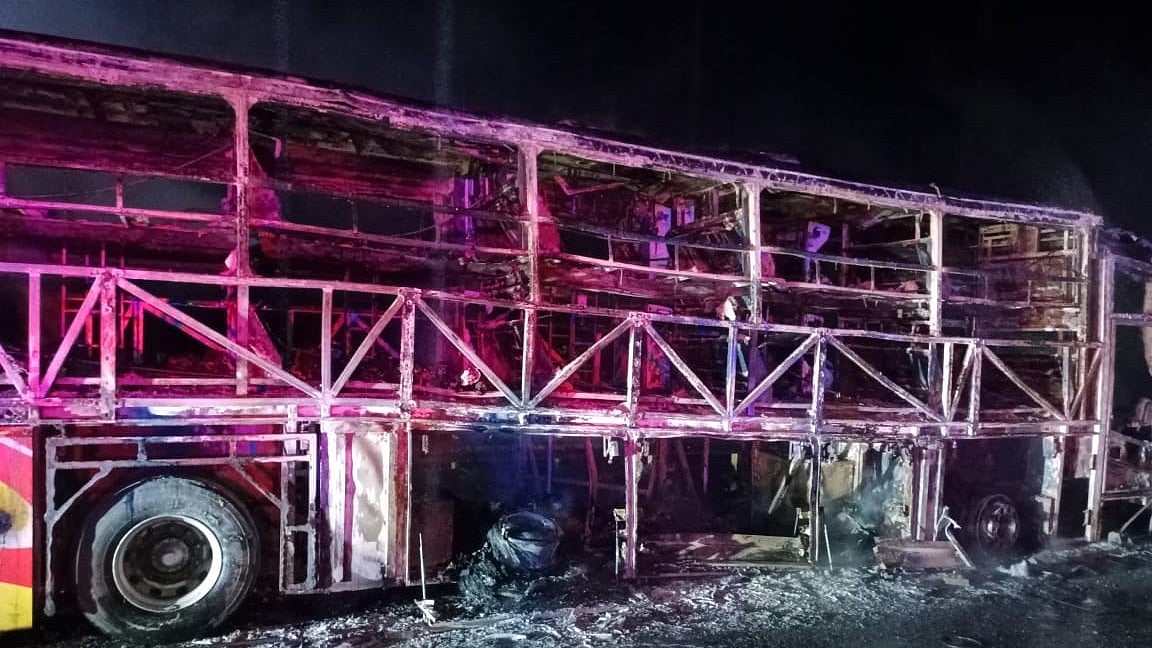In the early hours of October 24, 2025, a Bengaluru-bound private sleeper bus from Hyderabad collided with a motorcycle around 3 am, erupting into flames and claiming 20 lives. Most passengers, asleep in their berths, perished before realising the danger, their bodies burned beyond recognition. Survivor S Harika from Nellore described waking to chaos: "I saw the fire engulf the bus, it spread within seconds."
She and a few others escaped through a broken rear door, sustaining minor injuries like a forehead wound. Harika, an IT professional traveling for personal work, is stable in hospital but carries the trauma. The bus was reduced to a charred shell, highlighting how these vehicles, meant for overnight comfort, often become inescapable infernos.
This tragedy echoes a pattern of deadly incidents. Just ten days earlier, on October 14, an AC sleeper bus on Rajasthan's Jaisalmer-Jodhpur highway caught fire mid-afternoon, killing more than 20 people. Passengers jumped from the moving blaze, which rolled 50 meters before stopping. Other major cases include a 2022 Yavatmal-Mumbai collision that killed 12 in a fire, a 2023 Maharashtra highway crash claiming 25 after hitting a divider, and a Jaipur-Delhi bus fire near Gurugram in November 2023, killing two and injuring many.
So, why do sleeper buses turn into death traps?
Design flaws are central. These buses feature 2x1 arrangements with 30-40 berths, each about six feet long and 2.6 feet wide—comfortable for rest but disastrous in emergencies. Narrow galleries allow only person to pass, causing bottlenecks during evacuations. The 8-9 foot height exacerbates risks, if the bus tilts, upper-berth passengers struggle to reach exits or windows, delaying rescues. Experts note that limited space traps people, causing more casualties.
Response mechanisms compound the peril. Sleeper buses ply long routes (300-1,000 km) at night, when driver fatigue peaks. A 2018 Ministry survey found 25% of drivers admitting to dozing off, especially midnight to 6 am. While some buses have drowsiness alerts tracking steering or facial cues, enforcement is lax. Passengers, lying asleep, have minimal reaction time—often just two critical minutes to escape. Seated or awake riders fare better, but upper-berth sleepers are particularly vulnerable.

Globally, sleeper buses originated for entertainers but were phased out due to accidents. China banned new registrations in 2012 after 13 post-2009 crashes killed 252, including a 2011 Henan fire (41 dead) and a 2012 Shaanxi collision (36 dead). With 37,000 buses on 5,000 routes pre-ban, China mandated rests from 2-5 am to curb fatigue. Today, only India and Pakistan heavily rely on them, despite expert pleas to the Ministry for a ban amid design flaws and high fatalities.
These buses prioritise affordability over safety, but recurring horrors demand reform, stricter regulations, better designs, or an outright ban to prevent more families from mourning lost loved ones in preventable fires.







